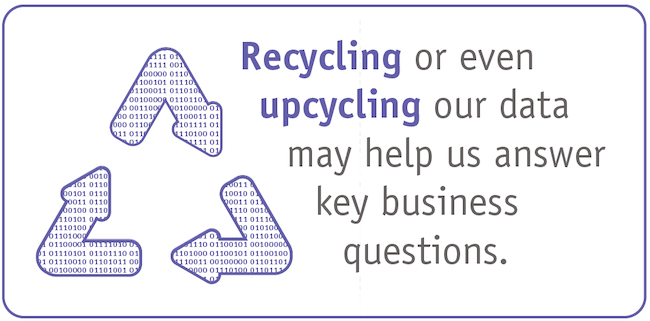Are you using bad data?
Editor’s note: Michael Howard is the head of marketing at market research firm Infotools.
Older cars, machines and appliances burn petrol, diesel or coal to operate. This has been instrumental in helping us to achieve specific, positive outcomes – powering factories, producing medicines, getting us from A to B. However, we’ve been left with toxic byproducts – also known as carbon emissions. This concept of unwanted byproducts is a great way to understand the efficiencies and outputs of how we use data in this modern age. After all, if fossil fuels powered the past, data is starting to fuel the future (if it isn’t already).
What are data emissions?
Data emissions are the unwanted byproducts that are generated when organizations use bad data in their operations or, alternatively, good data garnered through poor processes or the wrong technology. This waste might not initially seem to be as harmful to society, but under closer inspection it certainly appears it can be. The side effects are broad.
From a market research perspective, data emissions can include:
- Quality of insights. When insights teams are not operating sustainably, they are likely to produce ineffective or inaccurate insights, which can have multiple side effects for organizations.
- Advertising effectiveness and performance. Bad data and poor insights lead to advertising that does not generate the desired commercial outcomes it sets out to achieve.
- Messaging and brand positioning. Brands that aren’t producing quality insights are prone to positioning themselves poorly and going to market in ways that fail to resonate with or reach their target audiences.
- Supply and demand. This is one data emission that leads to tangible carbon emissions – the oversupply of products based on incorrect estimates of market demand. When organizations manufacture more products than are needed, additional carbon emissions are generated from the unnecessary production, transportation and disposal of the surplus.
- Data contamination. Poor processes and technology can have several negative consequences, such as the aggregation of respondent-level data.
- Data privacy. The leakage of personally identifiable information (PII) data or potential de-anonymization of PII from your customer data could leave organizations exposed to potential lawsuits.
- Reputation. Continued poor performance will expose the insights team to a potential loss of goodwill and lower perception within the organization.
- Profitability. Ultimately, the negative effects of data emissions culminate in the reduction of revenue and/or profit.
While they may seem to just have a theoretical impact, data emissions can produce real-world consequences.
Are you working to generate insights in a more sustainable way?
When we expand on this thought of emissions, we can consider that there are ways we used to analyze survey data and generate insights that are analogous to the gas-guzzling cars of yesteryear. Manual analysis and typical crosstab presentations are nowhere near as sustainable as the modern tools that are now available – even those without AI functionality.
As insights professionals, we need to look for ways to reduce the excess time spent on older ways of working so we can channel our precious time and resources on more value-adding, human-specific tasks. It’s not just the excess time that can be seen as an emission; the opportunity cost of missing valuable trends or insights is also worthy of being an emission.
Now, certain hybrid vehicles do well in converting energy – created by breaking into stored energy – for propulsion. Market research can do something similar by reusing data wherever possible to generate insights sustainably. The key here is to do so with little overhead and with a fast turnaround – not having to wait for other parts of the business to process it.
Where to focus your innovation
In the earlier days of electric and hybrid cars, we witnessed three approaches to the industry. First, there were those who were effectively naysayers, doubling down on internal combustion engines (ICEs). These organizations, for better or worse, were committed to optimizing their ICE engines to become as efficient as possible. There were also those who had a foot in both camps, innovating with both ICEs and with hybrid electric cars. And finally, there were those who were all-in on electric vehicles.
As a market research function, it is prudent to understand which path your organization is traveling down. Will you double down on traditional ways of working, making them as optimized and efficient as possible? Will you have feet in both camps, pairing traditional approaches with new tools and technology to generate insights? Or will you go all in and embrace the future of market research technology, even if it hasn’t been properly vetted?
Whichever option you choose will depend on the level of risk with which you are comfortable. Both the first and third options could prove to be high risk in the long term. The first option can be risky because traditional ways of working may become increasingly unproductive, to the point where the value of completing tasks simply isn’t worth it in comparison. The third option is risky due to the likelihood that one of the other multitudes of future potions becomes the market leader. The middle option is perhaps the least risky in the long term as you’re still working two angles, both of which can evolve over time as required.
Are you optimizing or reutilizing your existing data?
The cleaner your fuel the less emissions you (theoretically) need to process to use it effectively. That’s why it’s important to put the effort into collecting the purest market research data possible. After all, the cleaner our data, the sooner we can start extracting value from it.
However, collecting new data is not always the answer as we may already have what we need – we just haven’t looked for it yet. Many of us are aware of the benefits of recycling cardboard. In a similar way, recycling or even upcycling our data may help us reduce our data emissions footprint while answering key business questions.

Optimizing or reutilizing the data we already have makes a lot of sense, and it ensures we get maximum return on our historical market research investment. Obviously, we would all love data that is new and interesting to explore, but sometimes it’s when we analyze existing data that we can see shifts in behavior or insights we had previously missed, and then help our organizations act accordingly.
Here’s to reducing our data emissions footprint and helping our stakeholders be more effective and sustainable in 2024 and beyond.
